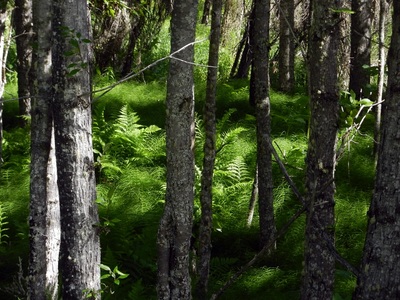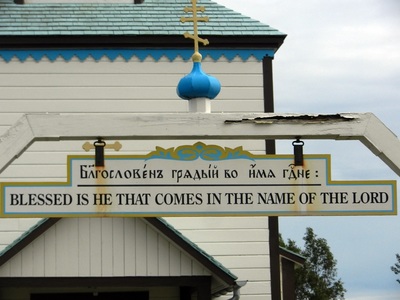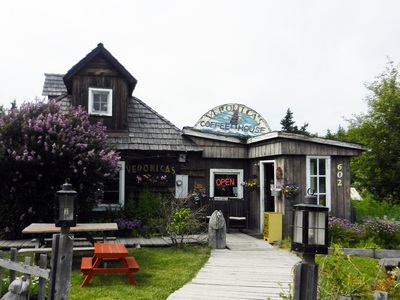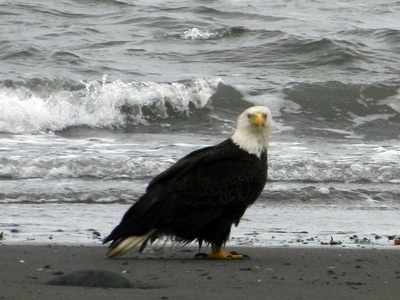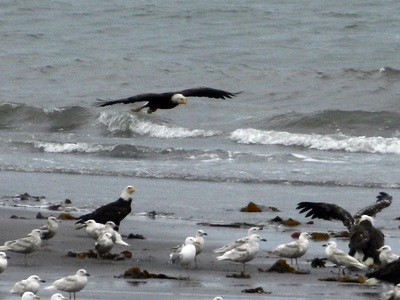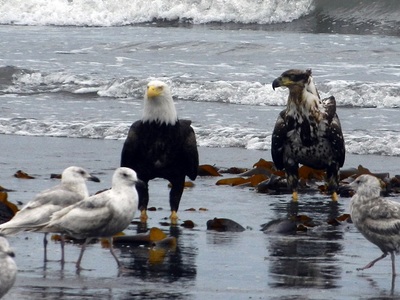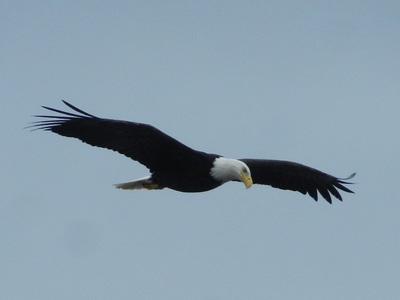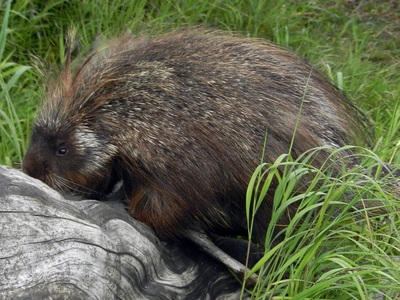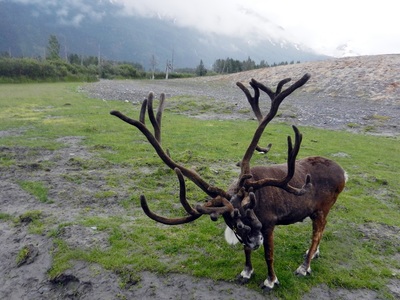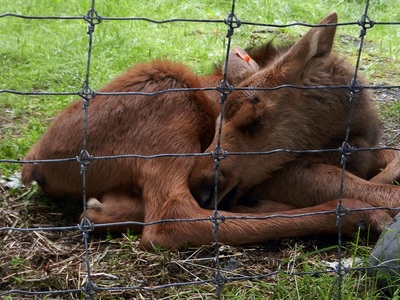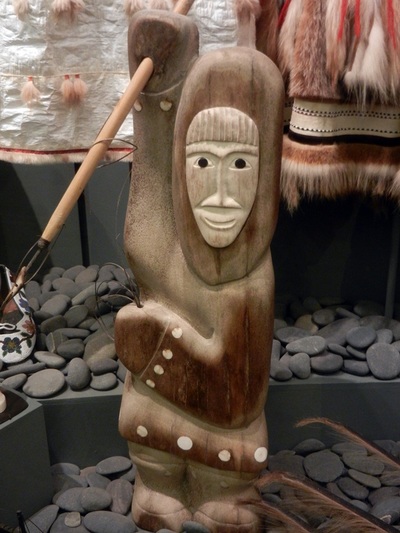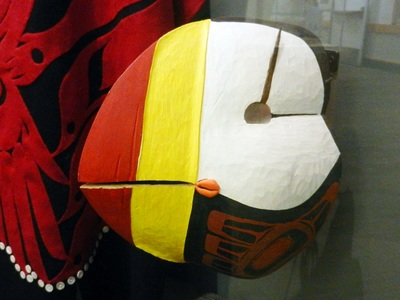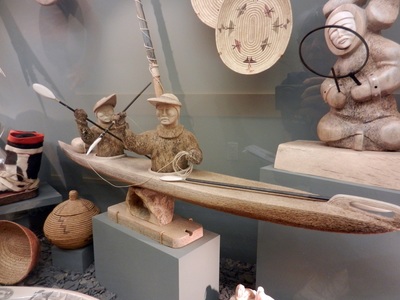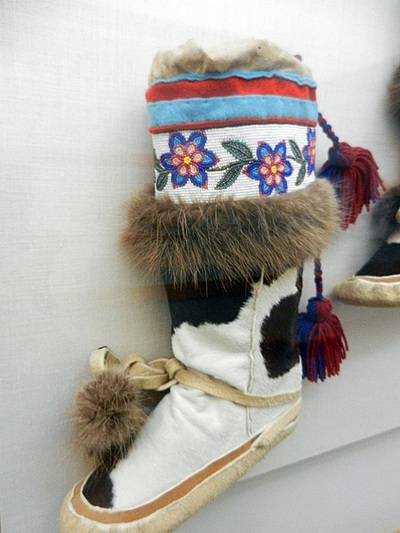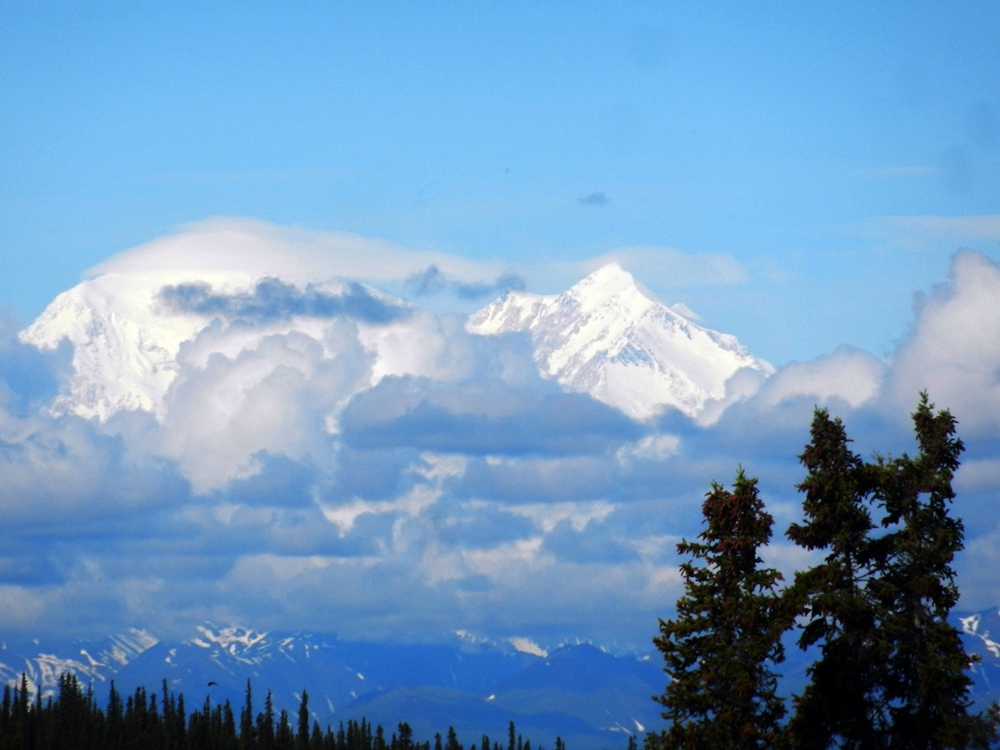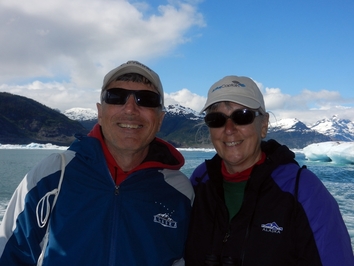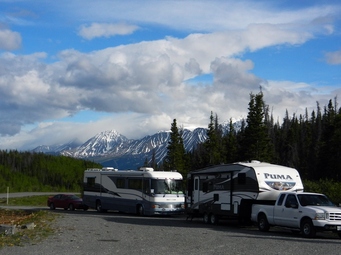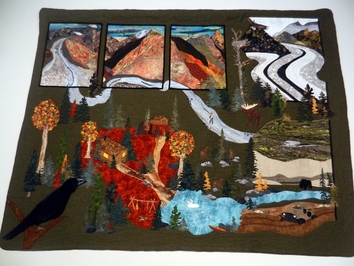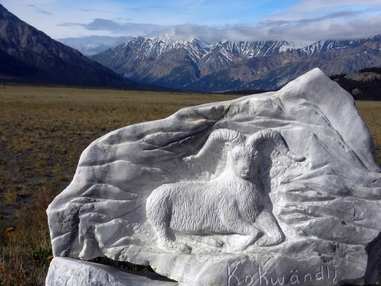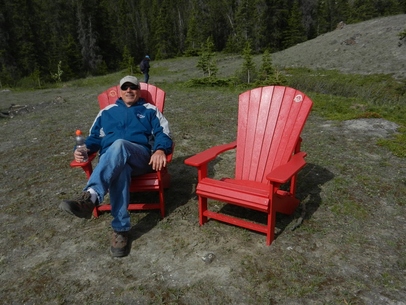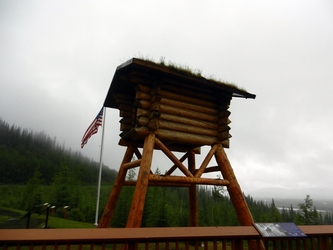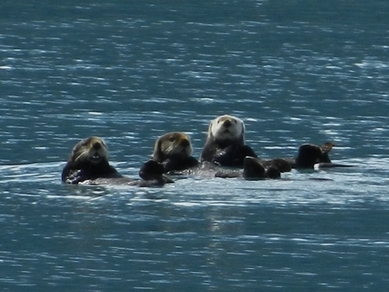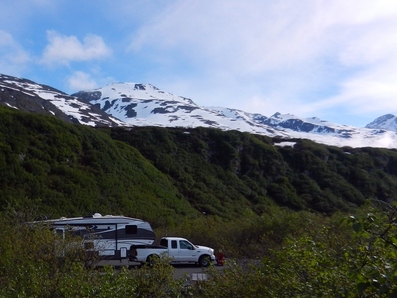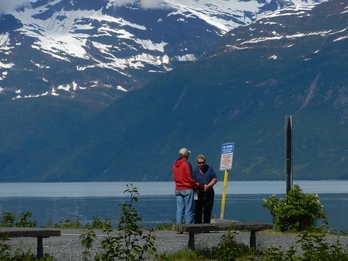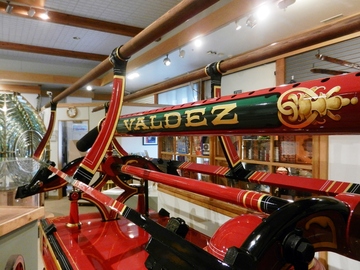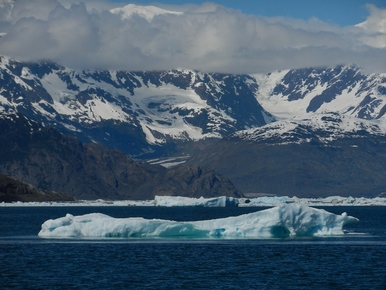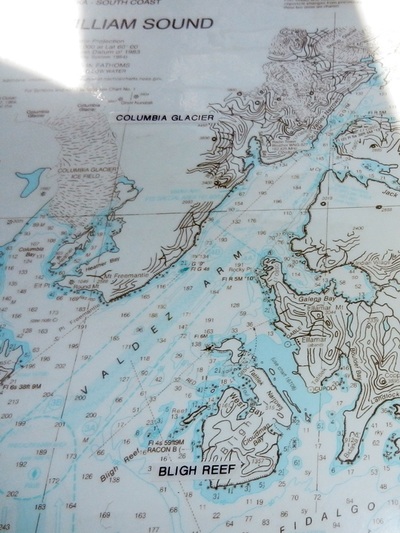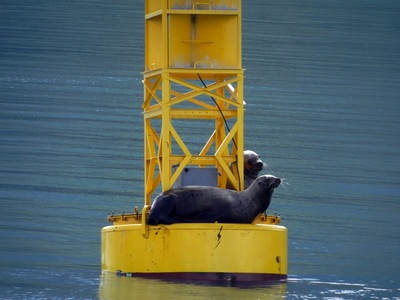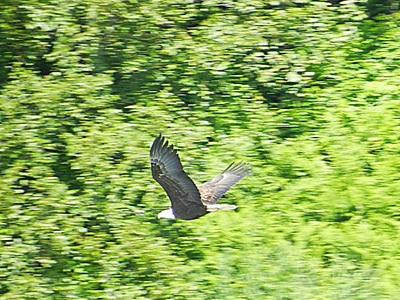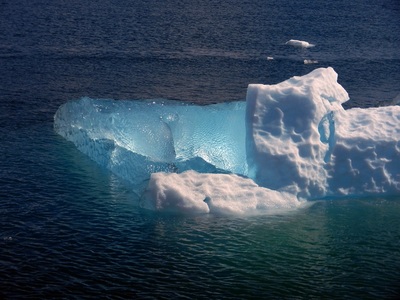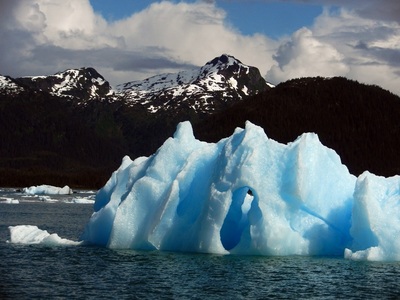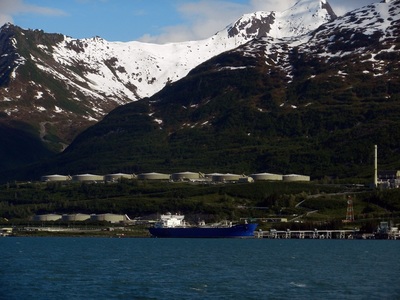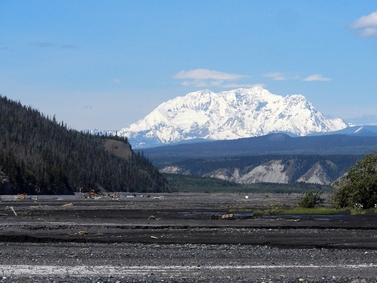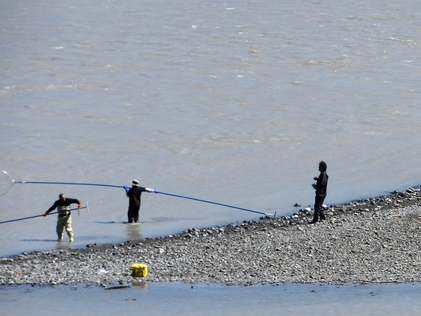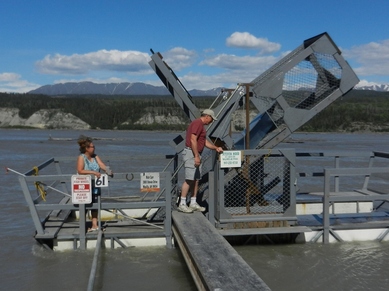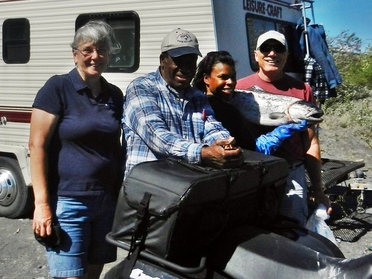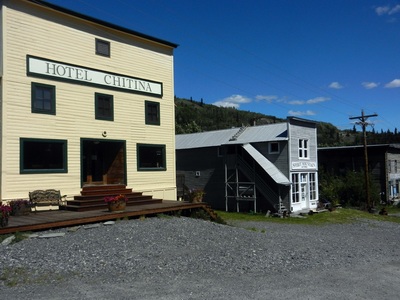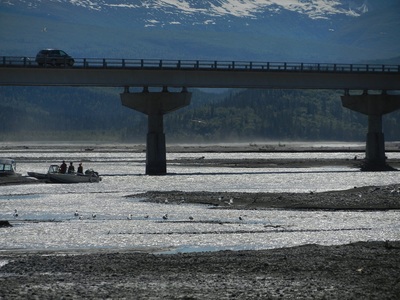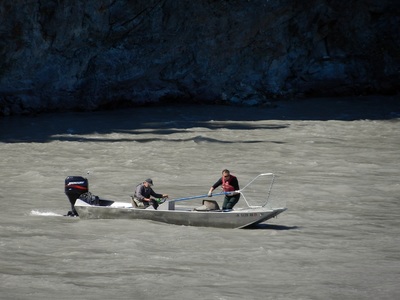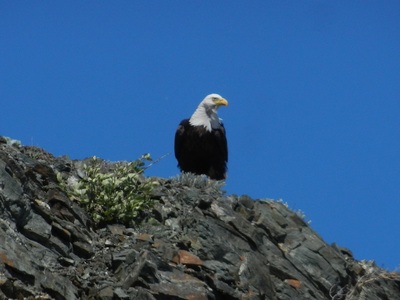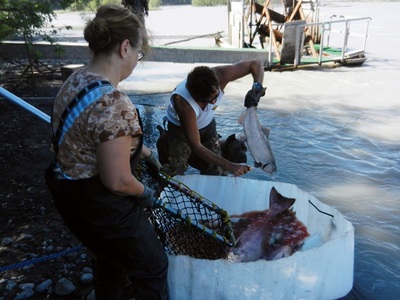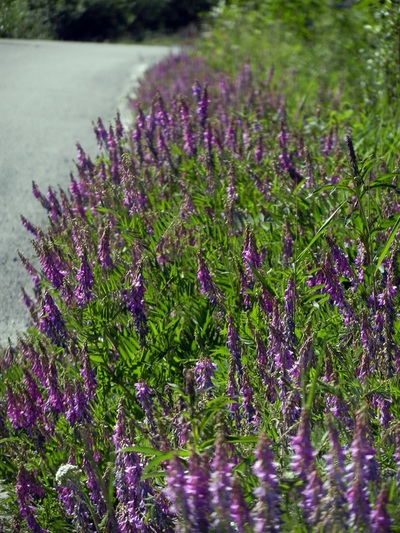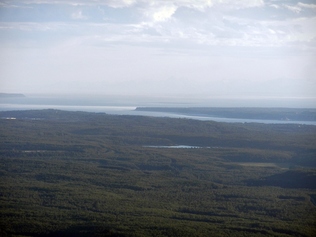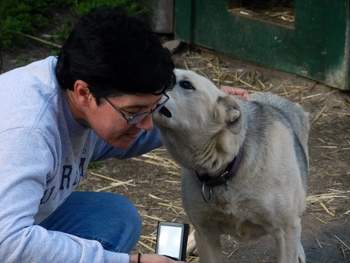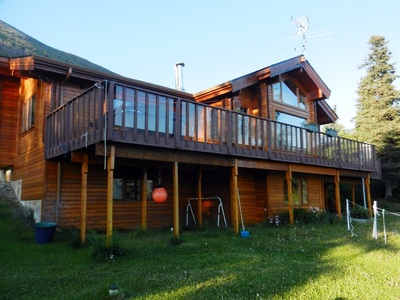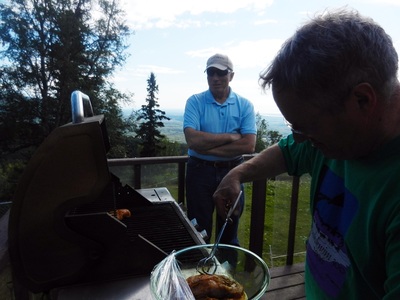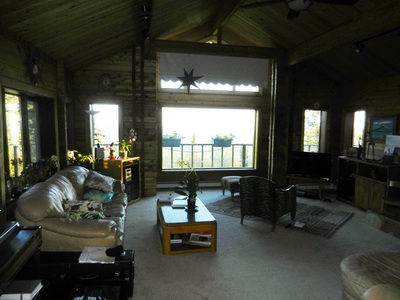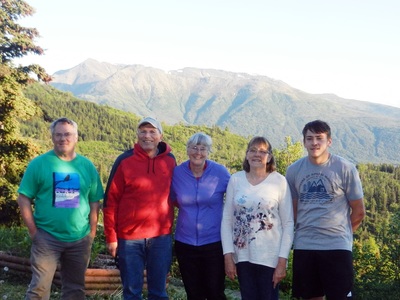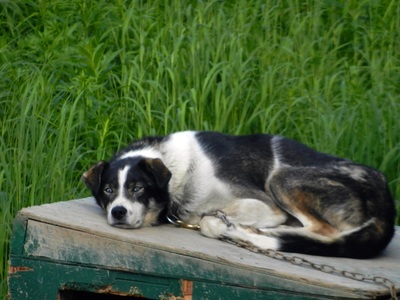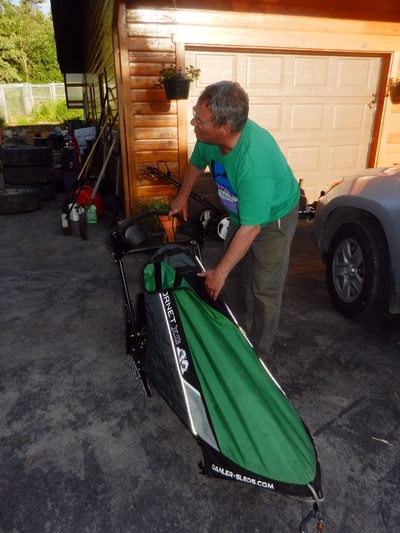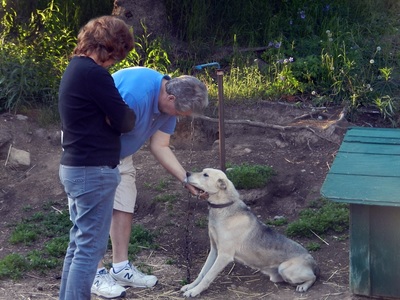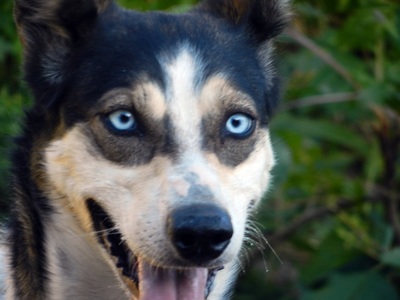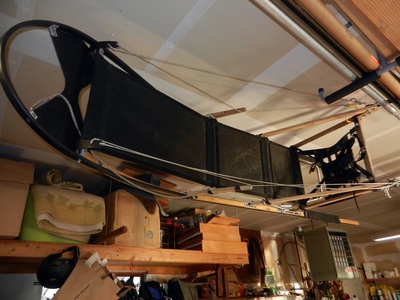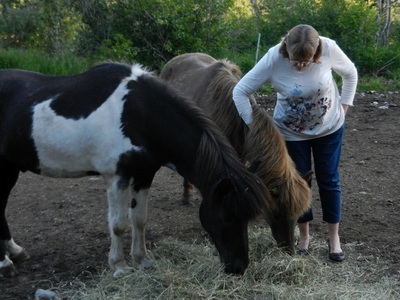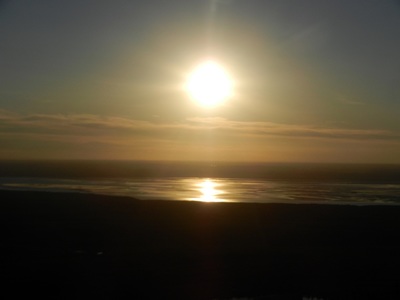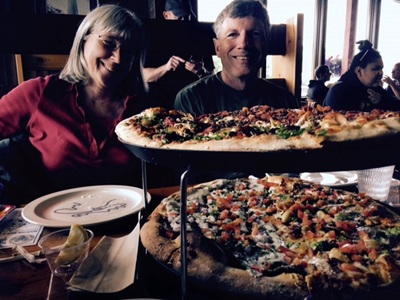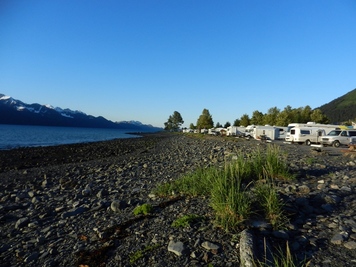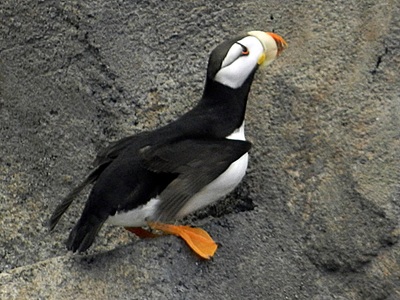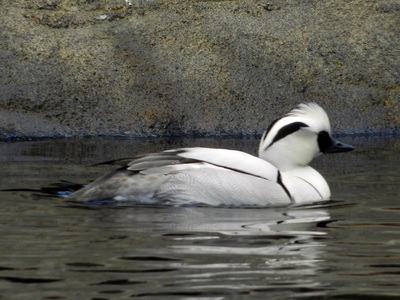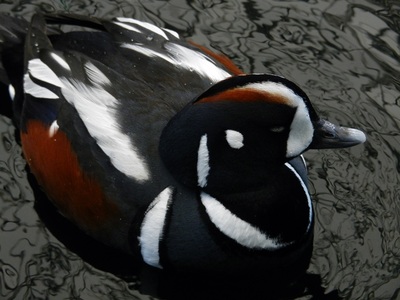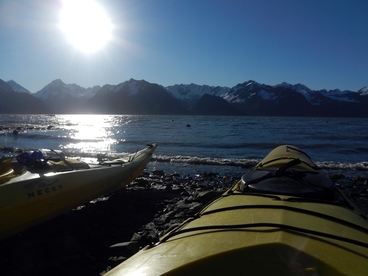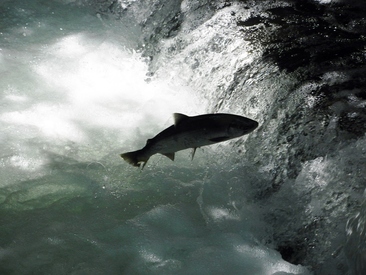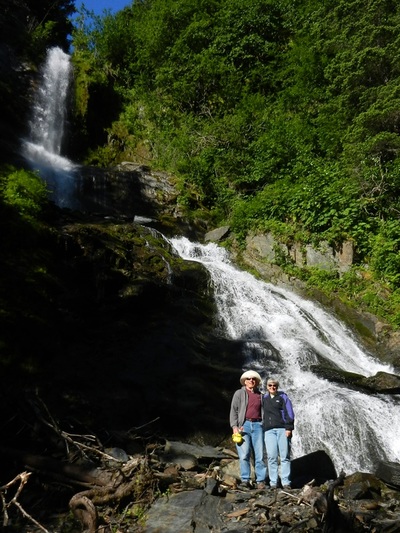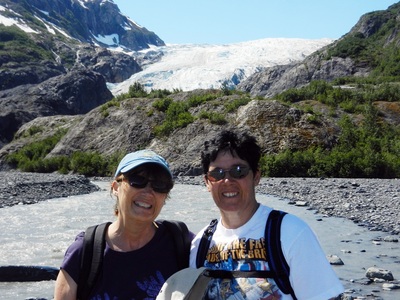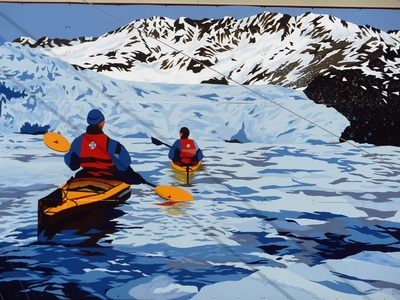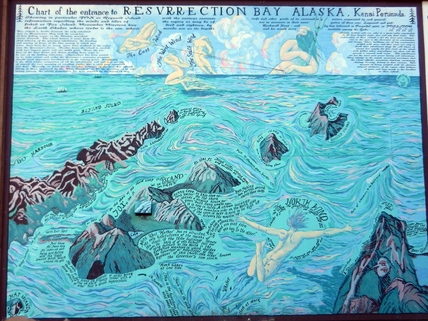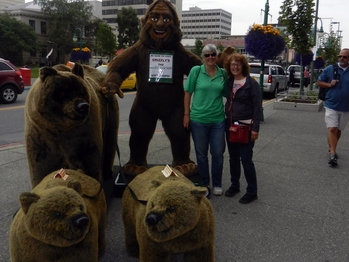 Cathy and Pat with friends in Anchorage
Cathy and Pat with friends in Anchorage We finished up our trip to the Kenai Peninsula and headed back to Anchorage for a few more days. This gave us time to see more of the city and to have some repairs made to both RV’s. A week later, we were moving north on the Parks highway toward Denali National Park, where we would spend the week of the 4th of July.
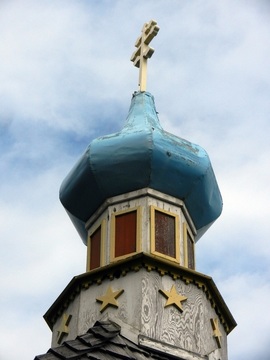 St. Nicholas chapel in Kenai
St. Nicholas chapel in Kenai South on the Kenai – Soldotna to Homer
We left Seward and the good weather behind us as we made our way west along the Kenai Peninsula to Soldotna. For one of the few times this trip, we found ourselves among a steady stream of traffic. However, our companions were mostly there for another purpose – the nearby Kenai and Russian Rivers were full of salmon running upriver, and these were fisherman who wanted to keep some of them from making it all the way home.
Around mid-day, we pulled into a Fred Meyer grocery store parking lot which would be our home for the next couple of days. This location had a free dump station and fresh water fill. They have space set aside for RV parking and allow 2 days of parking. They even have someone monitor the parking lot to ensure no one blocks access to the services. After picking up some ribs from the grill outside the store, we headed out to explore the area a bit.
We left Seward and the good weather behind us as we made our way west along the Kenai Peninsula to Soldotna. For one of the few times this trip, we found ourselves among a steady stream of traffic. However, our companions were mostly there for another purpose – the nearby Kenai and Russian Rivers were full of salmon running upriver, and these were fisherman who wanted to keep some of them from making it all the way home.
Around mid-day, we pulled into a Fred Meyer grocery store parking lot which would be our home for the next couple of days. This location had a free dump station and fresh water fill. They have space set aside for RV parking and allow 2 days of parking. They even have someone monitor the parking lot to ensure no one blocks access to the services. After picking up some ribs from the grill outside the store, we headed out to explore the area a bit.
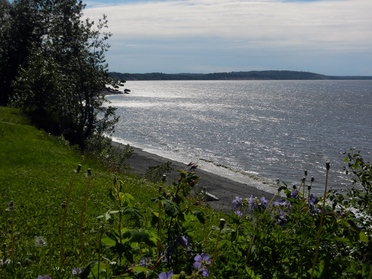 Cook Inlet from Captain Cook State Park
Cook Inlet from Captain Cook State Park The Soldotna Visitor Center is on the banks of the river next to a city campground. Throughout the town there are several “fishwalks” that give fishermen access to the river. One of these is at the base of the hill by the Visitor Center. From there we drove north as far as the road would take us, which delivered us to Captain Cook State Park and its commanding view of Cook Inlet. We caught a glimpse of a moose and her calf there. Our return trip took us by old Kenai, with its Russian Orthodox church, reminding us of Alaska’s history under Russian rule.
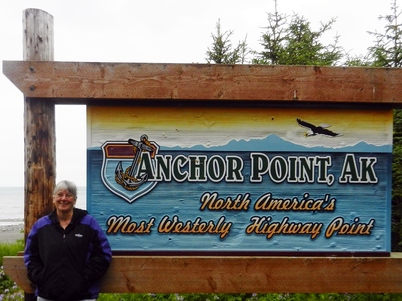 We achieve another weighty milestone.
We achieve another weighty milestone. The next day, we headed south from Soldotna toward Homer on the southern tip of the peninsula. Our first stop was at Anchor Point, which thanks to its geography lays claim to being the furthest west one can drive on a highway in North America. This point was next to a beach that was thick with gulls and bald eagles. As usual, the birds were there because the fish – and the fishermen – were there. At one point, a fisherman deposited his scraps on the beach. At this point, the eagles took charge. About a dozen adults and juveniles were making short work of the salmon.
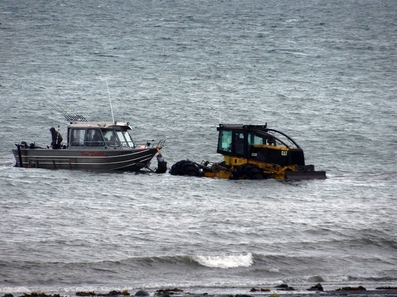 Tractor retrieving boat at Anchor point
Tractor retrieving boat at Anchor point We also saw one of the more unusual boat launching and retrieval techniques at this beach. A sizeable tractor powered out into the waves pushing a boat trailer and submerged itself almost to the top its huge tires. The boat being retrieved raced in from further offshore and powered into the trailer. A crew member on the tractor secured the bow and the tractor hauled the boat out.
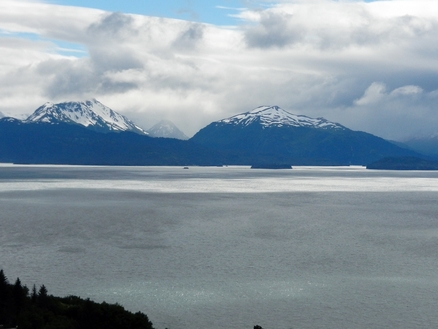 Looking over Cook Inlet and Kenai Fjords National Park from Homer
Looking over Cook Inlet and Kenai Fjords National Park from Homer Our southernmost stop was Homer, which extends a sandy spit into the inlet to separate Kachemak Bay from Cook Inlet. This is the jumping off point for Kodiak Island and the Aleutians. Given the distance behind us, we limited our time to a driving tour and headed back north, arriving back in Soldotna with enough time to check out Alaska Berries, a winery, plant nursery and source of jams from their fresh berries. We did a wine tasting and ended up leaving with some wine and jams between the four of us. One of the more unusual ones was from a haskap berry, which looks a little like an oval-shaped blueberry.
With our day’s touring completed, we called it a day and planned an early departure the next morning. Sunday's forecasted weather was for lots of rain, so we were going to make it a travel day, heading off the peninsula for Portage.
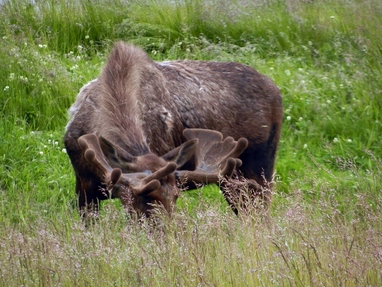 Bull moose at Alaska Wildlife Conservation Center
Bull moose at Alaska Wildlife Conservation Center Portage and Girdwood
Sunday turned out to be worse than the forecasts, as the rain was blown by gale force winds up Turnagain Arm. Since we had visited this area before, we skipped the visit to the Portage Glacier Visitor Center and the trip to Whittier on Prince William Sound. By the next day, the weather had moderated, so we took some time to view the animals at the Alaska Conservation Center, which sits on the old Portage townsite by Turnagain Arm, vacated after the 1964 tsunami devastated the town
Sunday turned out to be worse than the forecasts, as the rain was blown by gale force winds up Turnagain Arm. Since we had visited this area before, we skipped the visit to the Portage Glacier Visitor Center and the trip to Whittier on Prince William Sound. By the next day, the weather had moderated, so we took some time to view the animals at the Alaska Conservation Center, which sits on the old Portage townsite by Turnagain Arm, vacated after the 1964 tsunami devastated the town
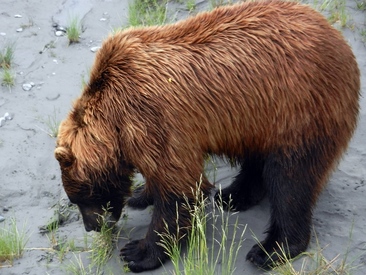
At the Center, we had amazing access to view Alaska wildlife up close. Moose, caribou, grizzlies, black bears, porcupines, wolves, foxes, wood bison, and more. The center takes in animals that have been injured or abandoned as juveniles. It takes pride in the fact that it was able to establish a herd of wood bison that were released into the wild last year and seem to be doing well. We took a free tour and watched a porcupine feeding (a delicate process) before heading out for the short distance to our stop for the night.
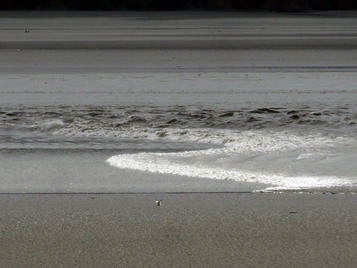 Bore tide in Turnagain Arm
Bore tide in Turnagain Arm It was a full moon and the summer solstice, so there was going to be a good bore tide in Turnagain Arm. The Seward Highway is carved out of the rocky hillside that runs right along the water. We chose a pullout to spend the night that was in a good position to see the tide roll in. What is a Bore Tide you might ask? It is when the leading edge of the incoming tide forms a wave that travels up a narrow river or narrow bay against the direction of the river or bay’s current. Precisely on schedule, around 6pm, the tide could be seen in the distance. Amazingly, there was someone surfing the tide as it came in. We had last seen a bore tide over 20 years ago at the Bay of Fundy. This one was equally impressive.
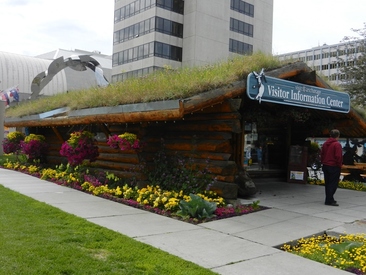 Anchorage log cabin visitor center
Anchorage log cabin visitor center Anchorage
Our stay in Anchorage was a mixture of work and sightseeing. After being off the grid since leaving Seward, we were ready to plug in, so we stopped at Ship Creek RV Park in downtown Anchorage. In addition to being close to downtown, it was near some biking paths along Ship Creek. We took advantage of this on a few different days. Having discovered a broken gear cable on Cathy’s bike back in Seward, we took this opportunity to replace it.
Our stay in Anchorage was a mixture of work and sightseeing. After being off the grid since leaving Seward, we were ready to plug in, so we stopped at Ship Creek RV Park in downtown Anchorage. In addition to being close to downtown, it was near some biking paths along Ship Creek. We took advantage of this on a few different days. Having discovered a broken gear cable on Cathy’s bike back in Seward, we took this opportunity to replace it.
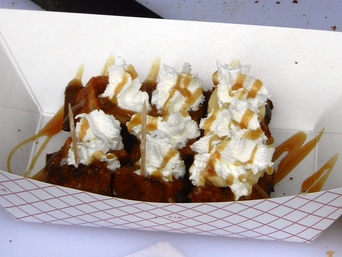 A custom-made waffle
A custom-made waffle We revisited some of the places we remembered from our trip 17 years ago and found some new ones. The Alaska Experience theater had some movies about the Aurora Borealis and the 1964 earthquake. The latter had “effects” that were a comical shaking of the seats that we had taken in on our last trip. We did some shopping and sampled some fare from the street vendors. However, we were really impressed with the offerings of the Public Lands building, which were free. They had a talk by a botanist from the Alaska Botanical Gardens, describing the flowers and berries growing in Alaska’s short season. And there were several movies, only one of which we had time for. Although we planned to return for more, we ran out of time.
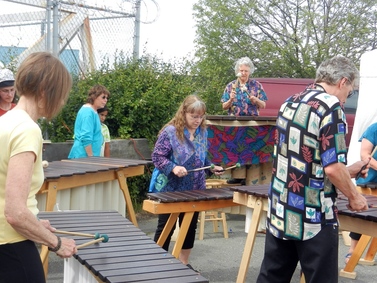 Musicians at farmer's market
Musicians at farmer's market We moved from Ship Creek to Cabela’s in south Anchorage after 3 days. This put us in position to take in the nearby Farmer’s Market on Saturday. At Lois’ recommendation, we moved from there to another in town and then a third. Lois joined us there and we had a nice afternoon as the morning’s clouds cleared away, listening to music and enjoying some local fare. Later, Lois took us on a tour of the Alaskan art at the Alaska Native Hospital. There was some amazing artistry on display from works of art given to the hospital by many of its patrons.
On Sunday, we moved north to Palmer, about 20 miles north of Anchorage. We joined Lois at her house for dinner and met Jessie Royer, a friend and an Iditarod champion who was visiting. We spent one more day in Palmer, provisioning for the trip north. We had been told not to expect any grocery stores of any size between there and Fairbanks. With our shopping done, we joined 1300 of the townspeople for the MatSu Miners baseball game (a collegiate league) against the Chugiak Chinooks. It was a record crowd and the home team won 4 to 3. An interesting thing to note was that the 7pm game didn’t require any lights, which was good since none were installed on the field. As we pulled out of the lot at 9:30pm, we still didn’t need headlights either.
With the rigs stuffed with food and supplies, we headed out north on the Parks Highway toward Denali.
With the rigs stuffed with food and supplies, we headed out north on the Parks Highway toward Denali.
RV Stuff
The battery issues that were seemingly solved by our new Iota battery charger continued to plague us. With several days off the grid, the batteries were requiring more and more charging time. By the time we reached Portage, we were seeing disturbing voltages – as low as 11.6. Dave even had to get up and run the generator in the middle of the night. In trying to find the source of the drain, we suspected the water pump, and then the battery charger itself. Not much else was running for any length of time.
By the time we reached Ship Creek, we decided it was possibly the batteries themselves were the problem. Dave took them back to Sam’s to get them tested. They replaced them and we’ve had no problems since. although they have not really been put to the test. With almost 2 weeks of dry camping at Denali coming up, they will get a real test.
The battery issues that were seemingly solved by our new Iota battery charger continued to plague us. With several days off the grid, the batteries were requiring more and more charging time. By the time we reached Portage, we were seeing disturbing voltages – as low as 11.6. Dave even had to get up and run the generator in the middle of the night. In trying to find the source of the drain, we suspected the water pump, and then the battery charger itself. Not much else was running for any length of time.
By the time we reached Ship Creek, we decided it was possibly the batteries themselves were the problem. Dave took them back to Sam’s to get them tested. They replaced them and we’ve had no problems since. although they have not really been put to the test. With almost 2 weeks of dry camping at Denali coming up, they will get a real test.
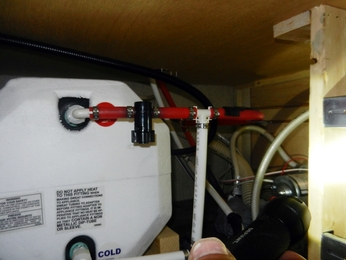
Another issue that we discovered upon arriving in Anchorage in mid-June was a problem with tje connection to city water. The city water was filling the fresh water tank and causing it to pressurize and overflow. We mapped out the water system to diagnose the problem. It appeared that a check valve was failing that should have kept the city water out of the tank. We dealt with problem in the interim by running off the fresh water tank and pump instead of city water. While in Anchorage this time, we took the RV to get this and our problem with the heat addressed by Mobile Auto and RV.
As these things go, the heat worked fine while the repairman was there and has since. Hmm . . . However, he did install a check valve in the water system that appears to have corrected the problem with city water. So far so good. We were very pleased with the service we received.
We’ll keep our fingers crossed that this is the worst of the problems we’ll encounter.
As these things go, the heat worked fine while the repairman was there and has since. Hmm . . . However, he did install a check valve in the water system that appears to have corrected the problem with city water. So far so good. We were very pleased with the service we received.
We’ll keep our fingers crossed that this is the worst of the problems we’ll encounter.
